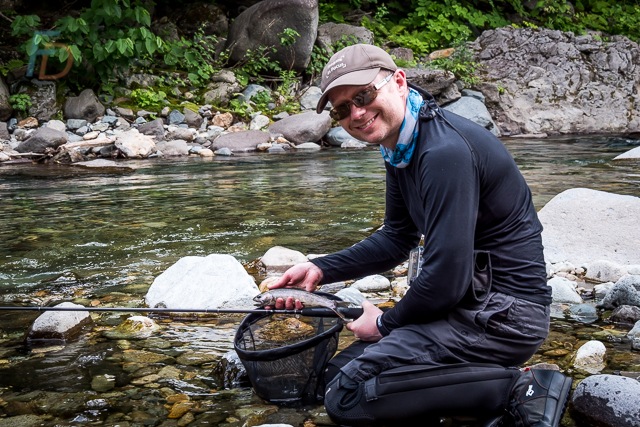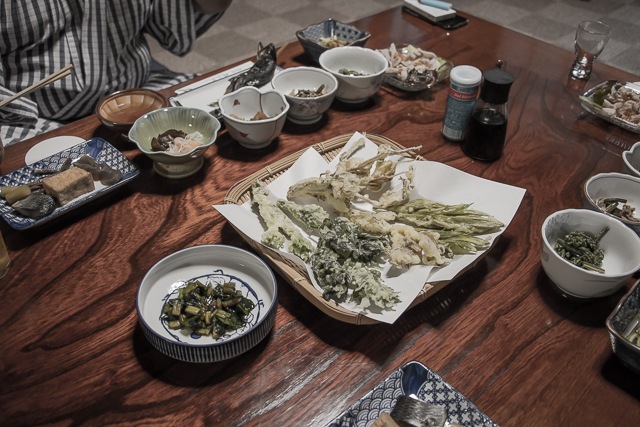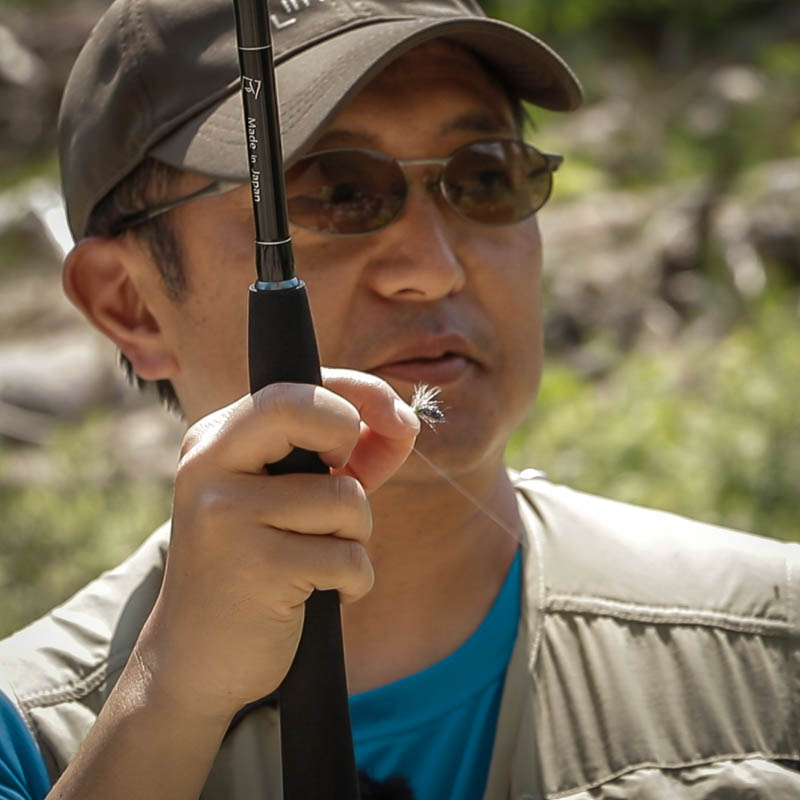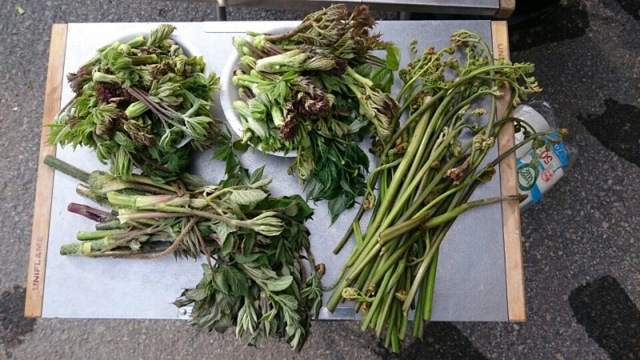The Last Shokuryoshi: Traditional Japanese Tenkara
Over the course of two annual visits to stay in the remote, traditional guest house “Yuzanso”, we interviewed (with the help of interpretation by Go Ishii) and fished with Kazuyuki Yamada to explore the roots of Japanese tenkara. John’s short film below captures the fast-disappearing “Shokuryoshi” way of life – and that tradition is documented “as is”. For this reason, we show the full catch and kill process – even though our own fishing for wild populations centres around catch & release ethics.
Discussion Continued below video…
The Old Meets New in Japanese Tenkara
As I’ll go on to show in the section below on Modern Japanese tenkara (the sport that has evolved from the traditions shown in the video), a new wave of catch and release ethics is beginning to spread in Japan. Yamada-san is very aware of how human lives are easily lost in the mountains (he took us to visit a settlement where 7 co-existing family households starved over one harsh winter). Even so, he was also perfectly accepting of us practicing catch and release in the river he had grown to rely on:

Foraging, Mountain Culture & Ryokan Guest-houses
In the meal preparation scene (video above), look closely at all the items on the table. As well as pickles made from locally-foraged wild greens – there is a huge plate of “sansai tempura”; also foraged that day. During the cooking scene, the small crisped batter items draining on the grill-pan in front of the stove are the deep fried bones of the fish.
These bones are delicious and have the nickname “senbei” – because they have the same taste and texture of the Japanese rice crackers of the same name. Those bones would also have been a vital source of calcium in an environment and culture without dairy.

This (delicious) use of absolutely every part of the fish caught – along with never over-depleting a patch of wild edibles while foraging – is an important part of mountain culture in Japan. It is also central to the ethos found within tenkara angling.
Why “Last” Shokuryoshi?
Yamada-san took on his father’s guest house in Akiyamago after he died. Approaching his 70’s at the time of our last visit, Kazuyuki Yamada is the youngest inhabitant in his village. In order to survive in that environment, it is essential to be able to clear your roof of the deep winter snow (5 metres of snow or more in winter is not an unusual situation). All of Yamada-san’s neighbours are older than him – so this hard work falls to him. When he is too old to do this for the neighbourhood, the village will, most likely, cease to exist.
So, as well as belonging to a proud line of the Shokuryoshi and hunters in the Matagi tradition, it is likely that Kazuyuki is the last of that lineage. This, of course, made our experiences during our visit incredibly powerful and moving. Perhaps a passionate buyer can be found for guesthouse Yuzanso and tenkara anglers can continue to visit as we have?
Traditional tenkara
Yamada-san uses a Gamakatsu “keiryu” (mountain river bait-fishing) rod because it has a similarly-powerful action to that of the traditional Shokuryoshi bamboo rod. He still favours his home-made horse-hair casting lines over modern alternatives – and the weight, texture and turnover of that line is a great match for the rod he chooses. In fact, in case the company stops making those, he has bought five or six spare rods (as these are very much like essential tools to him).
No Net/Tamo
Notice that, unlike many modern “sport” tenkara anglers, Yamada-san does not use a tamo (landing net). That was a relatively recent addition to tenkara – borrowed from the Ayu fishing culture. Instead, you can see how he backs up when he hooks a fish (away from the area where he might disturb fish). Then the fish is rapidly beached and, dispatched quickly before being added to the tree-branch “stringer” cut from a riverside bush.
Modern Japanese Tenkara
Uber-technical Japanese tenkara
Much more detail of the modern forms of tenkara are included in this detailed post. However, a quick characterisation of the highly-developed modern “sport tenkara” of Japan often includes the following features:
- Generally much lighter casting lines than those favoured by Traditional tenkara anglers
- Level fluorocarbon casting lines (with the notable example of Kura-san’s #3 nylon line approach)
- Full-flex rods that can cast these light, delicate lines
- Adaptations to large “Honryu” rivers
- High degrees of skill and success on hard-fished keiryu rivers

Modern Mountain Culture/Genryu Anglers
There is also a strong movement that includes tenkara anglers (such as Keiichi Okushi), where the fishing is only part of the whole experience. Instead, the hiking, light camping, survival/foraging aspect is at the centre of the experience. This calls on the skills and values of the original Matagi and Shokuryoshi traditions. It is an approach championed by Yuzo Sebata and requires a deep knowledge of the environment as well as of the plants and animals living there.

Many “Genryu” anglers are equally happy to fish with ultralight lure gear (the bfs or “bait finesse system” approach) as well as regular fly fishing. Of course, tenkara’s portability (and heritage as the fishing method used by matagi and shokuryoshi) also make it absolutely ideal.
Round up
Even if you never get the opportunity to fish in Japan, there are many attractive elements to both modern and traditional Japanese tenkara. The reliance on self and obtaining a deep knowledge and appreciation of the outdoor environment are just two of those admirable values. Accepting and embracing the restrictions created by a certain type of equipment (and how that can make you a much better angler) is also a wonderful way to improve your skills and enjoyment on stream.
Let me know what you think of John’s film and also your own thoughts on Japanese tenkara – versus other applications of rods and lines derived from that tradition. Just jump in on the comments below and have your say.
Of course, if there’s someone you know who also needs to see the film and the article, please do share it via social media, email, word of mouth or even on your blog if you have one.
Paul

Well done John. Allow yourself a smile. 🙂
And thank you as always David.
Paul
Hi Paul/John, regarding this film first it is very moving indeed, very well put together as always and the environment is beautiful.
I’m a relative newcomer to fly fishing and having followed your series on nymphing / Tenkara have realised the level of thought and analysis of my fishing is extremely poor. I have found the series to be quite inspirational and applaud your ethos which I now plan to follow. Once we get back out there I just can’t wait to try your techniques.
Kevin, thank you for the wonderful feedback and we’ll certainly do our best to support you.
Also, as hard as it is to remember; the aim in fishing isn’t to master it (or “complete” it) – it’s just to keep doing it and keep enjoying it – learning all the time. There’s always someone that every angler can learn from and it doesn’t matter where you are on that curve, because we’re all going in the same direction together 🙂
P
This is a wonderful film, John. Thanks so much for making it and sharing it with us.
I know John’s seen your comment Jerry and is super pleased that you like it (I just spoke to him on the phone; though I’m the one logged in to the site right now 🙂 )
Paul
I can confirm that John (as he does from time to time) is smiling about this film 🙂
Paul
Atmospheric filming and beautiful music to accompany it, which hit just the right mood for me.
No voiceover needed.
Took me away from lockdown for a few minutes. Thanks and best wishes to both John and Paul.
Clive, we’re very happy to have made something to brighten your day 🙂
I really liked the artistry telling this very moving story of a vanishing tradition. This poetry brings an emotional dimension to an activity that I too often take superficially. Please post more of John’s skilled videography.
Thank you Ted, my great apologies that I only just managed to sift your comment out as a genuine comment from a sudden wave of spam!